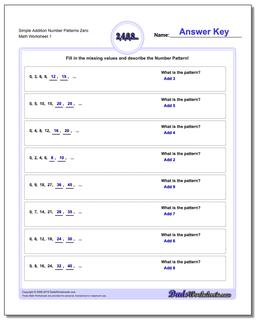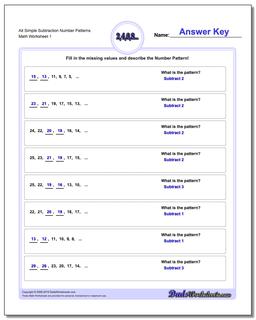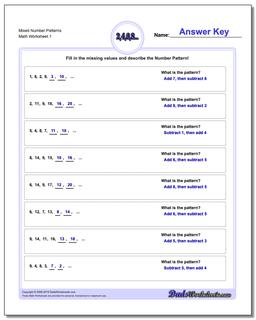Core Math Worksheets
Fraction Worksheets
Algebra
Other Worksheets
Place Value
Percentages
Rounding Numbers
Ordering Numbers
Standard, Expanded, Word Form
Mean Median Mode Range
Ratio Worksheets
Probability Worksheets
Roman Numerals
Factorization, GCD, LCM
Prime and Composite Numbers
Pre-Algebra
Geometry Worksheets
Blank Clocks
Telling Analog Time
Analog Elapsed Time
Greater Than and Less Than
Money
Arithmetic Sequences
Geometric Sequences
Venn Diagram
Graph Worksheets
Measurement & Conversions
Patterns and Puzzles
Color by Number
Holiday & Seasonal
Early Learning
Printables
Calculators
Math Worksheets by Grade
Worksheet News
Number Patterns
This page contains links to free math worksheets for Number Patterns problems. Click one of the buttons below to see all of the worksheets in each set. You can also use the 'Worksheets' menu on the side of this page to find worksheets on other math topics.
Addition Number Pattern Worksheets
32 Number Patterns Worksheets
Number patterns problems using only addition operations. These are a great first step for common core requirements for number patterns in 4th grade. The patterns in these worksheets will be multiples of the pattern number, and they can be a good bridge between addition and multiplication facts.
Addition Number PatternsAddition Patterns At Beginning/End Worksheets
32 Number Patterns Worksheets
Number pattern worksheets still using only addition operations, but with gaps at beginning or middle of the series. This forces the student to work the pattern in reverse to determine preceding values in the sequence.
Addition Patterns At Beginning/EndSubtraction Number Pattern Worksheets
28 Number Patterns Worksheets
Number pattern problems using only subtraction operations.
Subtraction Number PatternsSubtraction Patterns At Beginning/End
28 Number Patterns Worksheets
Number pattern problems using only subtraction operations, but with gaps at beginning or middle of the series.
Subtraction Patterns At Beginning/EndAddition and Subtraction Patterns
12 Number Patterns Worksheets
Combinations of addition and subtraction patterns.
Addition and Subtraction PatternsMixed Operation Patterns
20 Number Patterns Worksheets
Number patterns using both addition and subtraction operations in the same (more complex) pattern.
Mixed Operation PatternsPatterns with Multiples of Five
32 Number Patterns Worksheets
This section includes number patterns involving multiples of fives. Multiple-of-five fluency greatly helps in solving money and time problems, estimation and many other areas.
Patterns with Multiples of FivePatterns with Multiples of Ten
28 Number Patterns Worksheets
Patterns designed to show changes by ten; excellent reinforcement for place value concepts, money problems dealing with quarters, making change, etc.
Patterns with Multiples of TenPatterns with Multiples of Fifteen
36 Number Patterns Worksheets
Patterns designed to show changes by fifteen. Fifteen is a multiple used in time and angular measurement in degrees.
Patterns with Multiples of FifteenPatterns with Multiples of Twenty-Five
28 Number Patterns Worksheets
Patterns designed to show changes by twenty-fives; excellent reinforcement for money problems dealing with quarters, making change, etc.
Patterns with Multiples of Twenty-FivePatterns with Large Numbers
20 Number Patterns Worksheets
Addition and subtraction number pattern problems with larger values... These are really challenging!
Patterns with Large NumbersMultiplication Number Pattern Worksheets
16 Number Patterns Worksheets
These multiplication number patterns worksheets can also help with mastery of times table facts.
Multiplication PatternsFibonacci Number Patterns
20 Number Patterns Worksheets
Fibonacci and Fibonacci-like number pattern problems, where the next values in a sequence are dependent on prior values.
Fibonacci Number PatternsNumber Pattern Worksheets
The number pattern worksheets on this page a great practice for math tests your students will encounter in the classroom or on state evaluations. While number patterns are frequently addressed only briefly in many math curricula, practice with number patterns is a great way to boost not just test scores but number fluency.
What are Number Patterns?
Number patterns are a very common type of problem where a student is given a sequence of numbers and asked to identify how that list is generated and what the next values will be. They are regular features on standardized tests and you will also find them as part of the Common Core standard (specifically 4.0A.C.5) in the United States. Simple number patterns are typically introduced in 4th grade and their concepts are reinforced through 5th and 6th grade, but more complex geometric number patterns with more complex rules (such as the Fibonacci sequence) are common test questions all the way through high school grades.
Teaching students to identify and comprehend number patterns goes beyond fundamental arithmetic skills and teaches logic and pattern recognition skills as well. In a typical number pattern problem, a student is given a sequence of numbers and then has to describe the rule or pattern that generates the numbers. Often the problem will ask the student to provide the following numbers in the pattern, but some problem variants will also request the preceding numbers. Requiring a student to work a pattern forward and in reverse is one way to insure complete comprehension.
Basic Number Patterns
The most basic types of number patterns involve basic addition and subtraction rules, and they leverage a student's familiarity with skip counting patterns to quickly supply a corresponding rule. Many of these number patterns will start with a number further up in the sequence (for example, if the pattern is 'add 3', providing a sequence '12, 15, 18...').
Variations where the patterns count down (for example, the "minus 3" pattern with a sequence "21, 18, 15...") introduce subtraction number patterns.
Number patterns are also a great way to gradually build confidence recognizing sequences in an unfamiliar context. For example, the counting by threes pattern discussed above might start from a number not normally in the familiar pattern (for example, "5, 8, 11...") which creates an opportunity for a math learner to rediscover a familiar number pattern all over again.
Number Patterns with Common Increments
Many of the number pattern worksheets on this page deal with increments that are frequently seen in real-life sequences of numbers, and being able to identify these patterns quickly is a useful skill. You'll find patterns of fives, patterns of tens, patterns of fifteens and patterns of 25 here for practice. These are also great practice once students have mastered the basic addition number patterns or subtraction number patterns when they are looking for something slightly more challenging.
Multiplication Number Patterns and Beyond
This page also has a set of worksheets that have pattern rules utilizing multiplication and division operations. While this type of number pattern is less common in 4th grade or 5th grade when multiplication is just being introduced, you will find multiplication number patterns quite frequently on college entrance exams so building familiarity with these patterns is important.
Multiplication number patterns provide a bridge to geometric number patterns such as the Fibonacci sequence. These are patterns where the next value sequence is dependent on prior numbers. The Fibonacci pattern involves summing the two prior digits in the sequence, so the rule is essentially "Add the prior two numbers." The canonical Fibonacci pattern is "0, 1, 1, 2, 3, 5, 8..." and similar, but you will often see number pattern problems that start with a different base and use the same rule.
Other Number Patterns
Other types of number patterns that may occur are simply lists of common numbers, for example odds or evens, primes, composites, times. Reinforcing the concept of patterns as they occur in almost any application will leave students prepared to identify these when they appear both on math tests or in real life.













